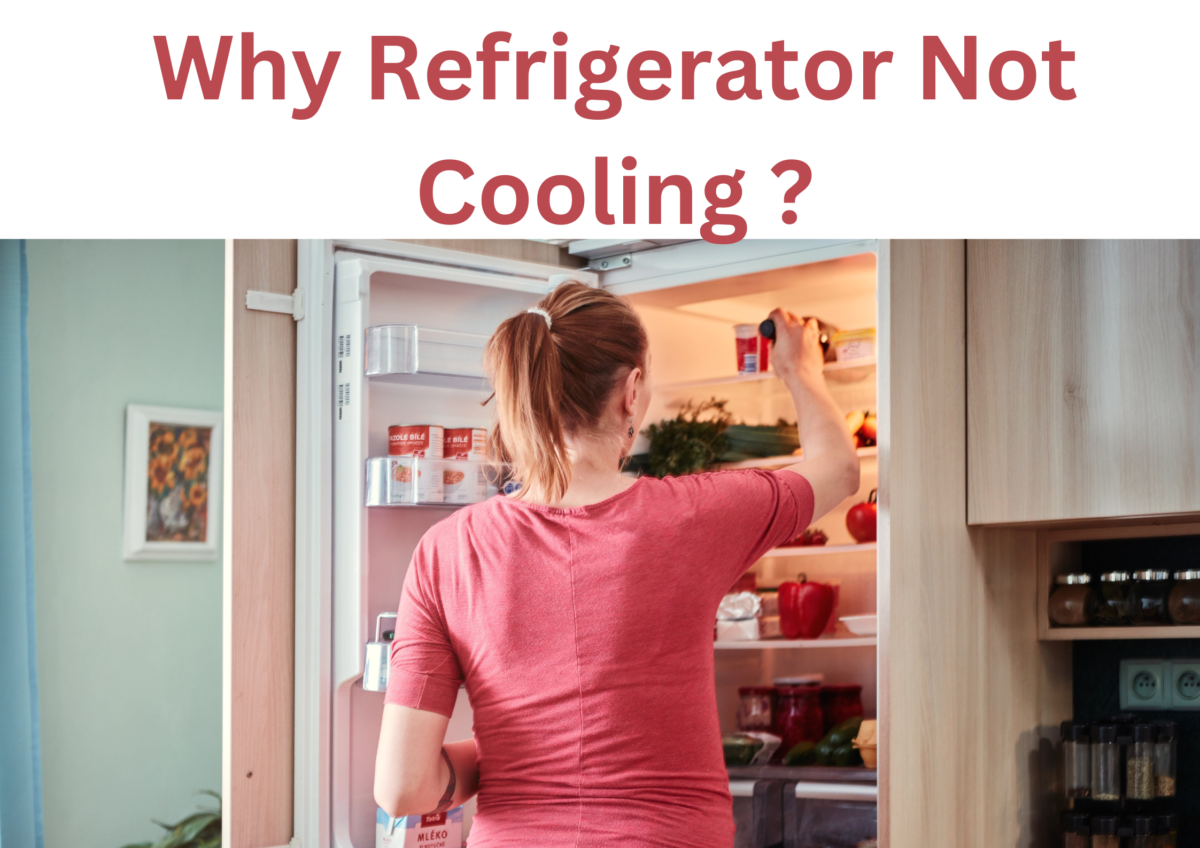Is your refrigerator not cooling properly? Are you finding sour milk or warm drinks inside your fridge? These are some clear signs that your refrigerator is not cooling. It not only wastes your food, and creates unpleasant odors but also causes health issues.
In many cases, the replacement of a refrigerator is not required. Some issues are not that much complicated to resolve and you can do it by yourself with a little elbow grease.
To solve the refrigerator’s cooling problem, you must first understand the reason behind it. In this article, the 8 most potential causes and solutions to the problem “Why refrigerator not cooling?” are discussed. Read the full article to learn more about the problems and the solutions.
Why Refrigerator Not Cooling?

1. Thermostat Is Improperly Set
Thermostats are used to control the temperature. It measures the temperature inside the refrigerator and controls its cooling process. If the measured temperature is lower than the desired value, then it turns the compressor off and stops the cooling process. If the temperature inside a refrigerator is high it again turns on the compressor and starts the cooling process.
The temperature inside a refrigerator should be ideally kept between to
. If the thermostat’s setting is deviated from this range, the refrigerator will not be cooled properly.
If your refrigerator’s compressor is running continuously but the refrigerator is not cooling appropriately, then it may be due to the improper setting of the thermostat.
Solution:
- Change the settings of the thermostat and fix the desired temperature value within
to
.
- Make sure to change the settings of both the refrigerator and freezer as both should have separate controls.
- After changing the temperature settings, wait the whole day to check whether it is cooling.
2. Dirty Condenser Coils
The condenser coils are located at the back side or, the bottom of the refrigerator. The high-pressure and high-temperature refrigerant gas moves from the compressor to the condenser coils. The coils help dissipate heat produced by the compressor and maintain the temperature inside the refrigerator.
The condenser coils are metal tubes, arranged in a U-shaped grid pattern. If these coils get dirty and covered in spiderwebs, they can not release the heat generated by the compressor. This increases the load on the compressor. Thus the refrigerator can not properly cool due to the blocked condenser coils.
Solution:
- Carefully clean the dust, spiderwebs, and other particles on the condenser coils.
- If you live in a more polluted area, clean the coils every 2 – 3 months.
- A regular cleaning is necessary if your house has significant pet traffic, as, the pet hairs often block these condenser coils.
3. Blocked Air Vents
The cool air generated by the refrigerator circulates throughout the freezer compartments and/or fridge by the air vents. Sometimes overstuffing the refrigerator with food, beverages, and other items, blocks the air vents. This prevents cool air from circulating inside the refrigerator. Thus, it decreases the cooling ability and efficiency of the refrigerator.
Solution:
- Reorganize the refrigerator and clean the air vents to restore the circulation of cool air inside the refrigerator.
- Check if there are any large boxes or bags, that are blocking the air vents and preventing the cool air from entering inside the refrigerator.
- Also check if there is any large layer of ice that is blocking the passage of air vents.
4. Installation Location
The refrigerator’s ability to maintain the desired cooling temperature also depends on the location where the device is installed. When the vapor refrigerant condenses into liquid form, heat is generated. This heat mixes with the environmental air to work efficiently.
So, for proper air circulation, the refrigerator should have enough clearance on the sides, especially in the back. The refrigerator needs 0.5-inch clearance on the sides and 1-inch in the back for optimal performance.
If your refrigerator is designed for indoor use, you cannot use it in the garage as it may not be able to cool properly.
Solution:
- Check if you have enough clearance on the sides and in the back of the refrigerator. You need to move the device, in case it does not have the proper clearance.
- Before installing a refrigerator, always follow the instructions on the user’s manual or the manufacturer’s website.
5. Dirty or, Broken Gasket Seals
The gasket seals create an air-tight barrier when the refrigerator’s door is closed. It is a soft and flexible seal that locks cold air inside the refrigerator.
If the gasket seals are broken, dirty, damaged, or, worn, it prevents the refrigerator from being properly sealed. It can cause your refrigerator to leak cool air. Thus, it reduces its cooling ability.
Solution:
- Clean the gaskets and edges of your refrigerator. Scrub or, wipe away the dirt, crumbs, or, other debris with soapy water.
- If after cleaning the gaskets, the cool air is continuously escaping then you may need to change the gasket seals. For this, you can call a technician to diagnose whether it is necessary to change the gaskets or not.
6. Overpacked Contents
An overpacked or cluttered refrigerator may find it difficult to maintain the temperature inside the device. If the contents inside the device are unorganized then it may impact the cooling operation. It prevents proper airflow inside the device and decreases the cooling efficiency.
Solution:
- Reorganize the contents inside the refrigerator so that the air vents remain open and the temperature inside the device will be maintained.
- Don’t overpack the refrigerator. Keep only one-third of the inside space full of foods or, beverages to allow proper air circulation.
7. Not Properly Leveled
If the refrigerator is not installed on a flat or even surface, the doors may not close properly. This impacts the cooling ability of the device.
While installing a refrigerator put a level underneath it to check if it is properly leveled or not.
Solution:
- Slightly move the refrigerator and check the leveling. If still it is not leveled, then you may need to install shims to keep it leveled.
8. The power Source Is Unplugged or, Switched Off
If the refrigerator is not cooling then, check if the power source is still plugged into the electrical outlet. Also, check if the switch that powers your kitchen appliances is on or off. Switched on the refrigerator to keep it operated and cool.
When Should You Call a Professional for Help?
- If you have tried all the above solutions, and you are still facing cooling problems you should take help from a professional.
- If you notice any sparking or, burning smell from the refrigerator, you should call a technician.
- If you are facing problems with fan motors, compressors, thermostats, evaporators, etc. then you should call a technician.
There are several reasons such as improper settings of thermostats, dirty condenser coils, blocked air vents, dirty gasket seals, installation location, leveling problems, overpacked contents, etc. which prevent refrigerators from being cooled properly. Some problems are not very difficult and you can solve them by yourself by following the above instructions. But refrigerators also face some major issues with compressors, thermostats, evaporators, fan motors, etc. which you should take from professionals.
Also Read
- Side By Side Vs French Door Refrigerator 2024
- Counter Depth Refrigerator vs. Standard Refrigerator: Which One Is Better?
- Where Should I Place My Air Purifier? 2024
- How Do You Know If You Need an Air Purifier? 2024
- HEPA Air Purifier: Definition, Types, Uses, Efficiency, Working Principle
- Whole House Air Purifier: Types, Pros, Cons, Working Principle 2024
- Air Purifier Advantages and Disadvantages
- How Do Air Purifiers Help? 6 Benefits
- Whole House Dehumidifier: Types, Working Principle, Pros, Cons 2024
- How Does a Commercial Dehumidifier Work? 2024
- How Does a Dehumidifier Work? Types, Uses, Benefits 2024
- 10 Tips for Buying a Dehumidifier
- Dehumidifier Vs Air Purifier 2024
- Dehumidifier vs. Air Conditioner 2024
- Cool Mist Humidifier: Types, Uses, Benefits, Working Principle 2024
- Do Humidifiers Help with Air Quality? 2024
- When Do You Need a Humidifier? 8 Common Signs
- How Do Humidifiers Work? A Complete Guide 2024
- How Humidifier Helps Breathing? 2024
- Humidifier Vs Dehumidifier Vs Air Purifier: Which One Should You Buy? 2024


14 thoughts on “8 Reasons Why Refrigerator Not Cooling and Solutions”